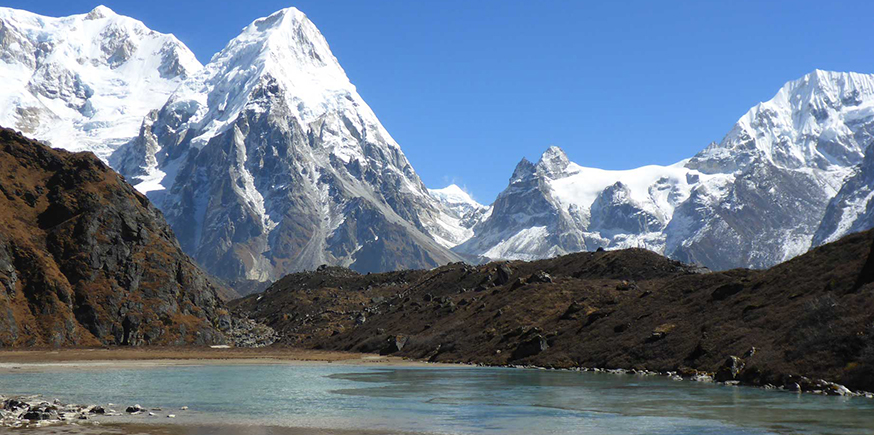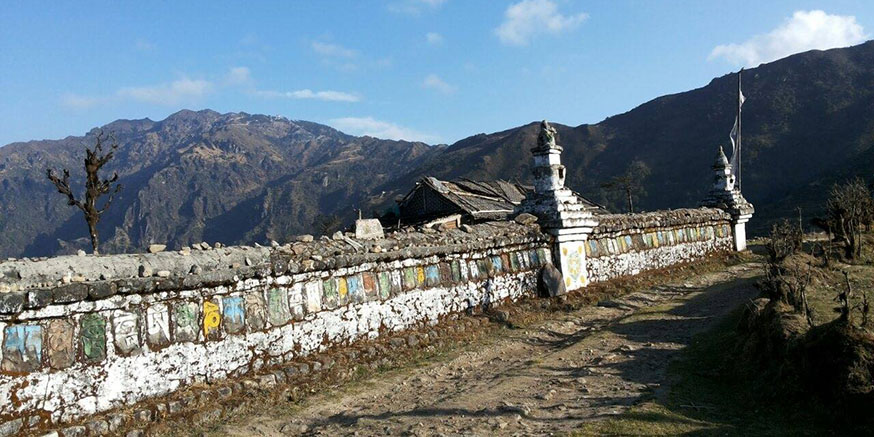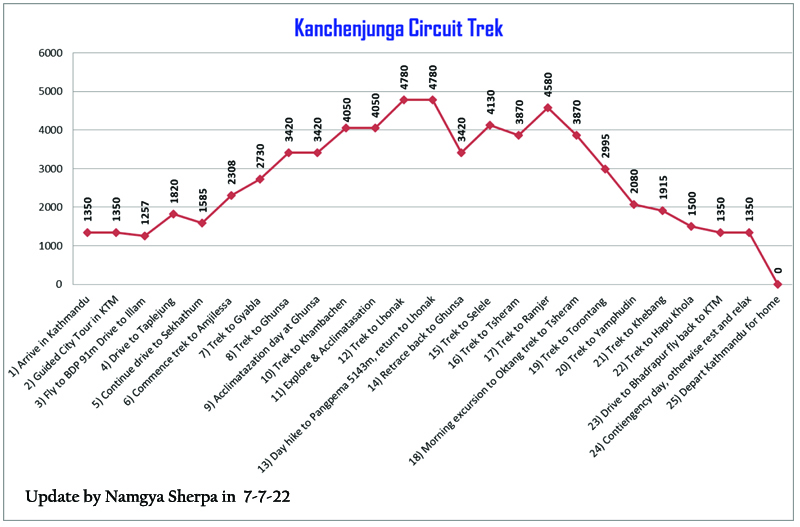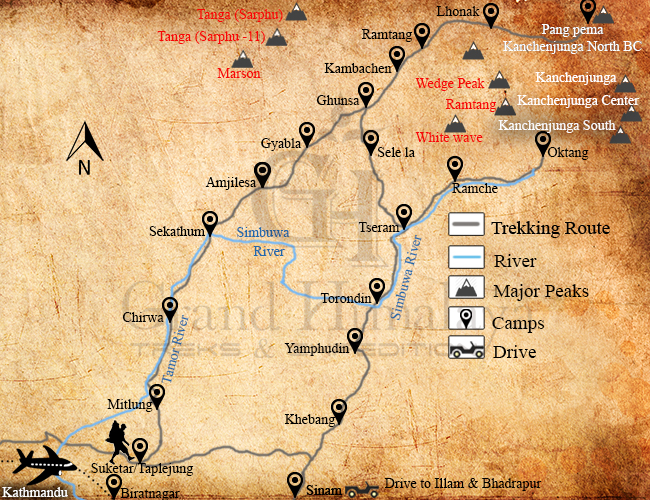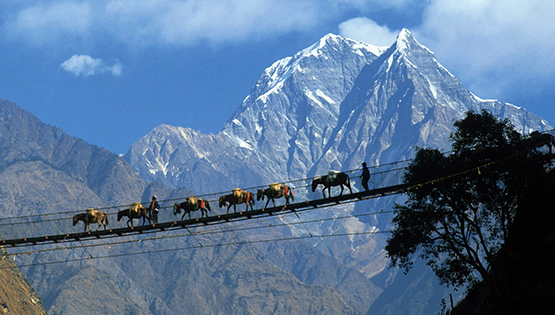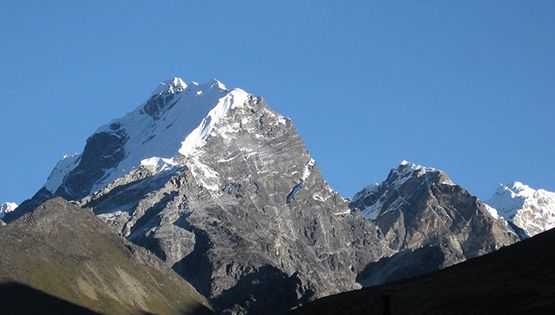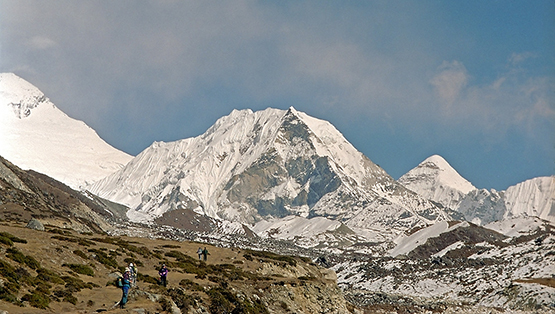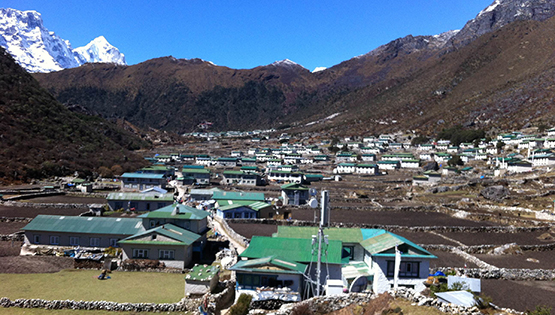At 8,586m, Kanchenjunga is the world's 3rd highest mountain. Located in the far north eastern corner of Nepal, on the border with Sikkim, the surrounding region is less accessible than the Khumbu or Annapurna and still sees few Western visitors. Kanchenjunga has a special place in the hearts of British climbers and explorers. From Douglas Fresh field initial circumnavigation in 1899, the first ascent in 1955 by Joe Brown and George Band, to the ground-breaking ascent of the North Ridge, by Doug Scott, Pete Boardman and Joe Tasker in 1979 - many chapters in British climbing history have been dedicated to "Kangch". Together with the huge bulk of Jannu, Chang Himal's imposing North Face and the impenetrable ridges of Ratong, the mountain vistas on this trek are every bit as impressive as the peaks in the Everest region. Our itinerary approaches the North Base Camp first, trekking through deep ravines, forests of bamboo, rhododendron and larch pine to the Tibetan village of Ghunsa and the high mountains. We take care to spend time acclimatizing around Ghunsa and Kambachen, before continuing along the Kanchenjunga Glacier to spend a night at Pangpema, base camp on the north side. The views of Jannu, Kanchenjunga and Chang Himal are jaw dropping. Then we cross the Mirgin La (4,550m) to Tseram. It is much more logical to cross the pass from north to south and this part of the trek is simply superb. Magnificent scenery and interesting walking. By now we're well acclimatized, and can enjoy the gentle walking up to Oktang and the awesome views of Ratong, the Kabru Peaks and the South Face of Kanchenjunga. We exit the mountain via an esoteric route, travelling through villages where the locals rarely see trekkers. Expect to be the focus of much attention! This is a long and committing trek in a region with little infrastructure. The trails are at rough and undulating, at times exposed and there are landslides to cross. Therefore to join this trip you need to be an experienced mountain walker, mentally prepared for consecutive days of tough trekking in an extremely remote part of the Himalayas. Trekking to the North Base Camp first, then crossing the Mirgin La (Pass) from North to South to then visit the South Base Camp is, in our opinion, the best way of doing this trek.
A very warm welcome to the Kingdom of Himalayas. Upon your arrival at the Tribhuvan international airport our representative welcomes you and assists you transfer in your hotel in Kathmandu. After time to get refreshed, evening you'll meet and transfer for welcome dinner in one of the typical Nepalese restaurant in the heart of Kathmandu i.e. Utsav or Nepali Chula (Kitchen). Here you will not simply experience the traditional Nepalese dish but will be entertained with Nepalese traditional dance and folk songs. After the dinner, you will be transferred back to your respective hotel.
Kathmandu is the historical and cultural heart of Nepal and has been a popular destination for tourists ever since Nepal opened its doors to visitors. The city presents a wonderful mix of Hinduism, Tibetan Buddhism and Western influence in the Valley. Bauddhanath: Stupa with its 130 ft. dome. One of the world's largest Stupa, Bouddha is generally acknowledged to be the most important Tibetan Buddhist monument outside Tibet. Pupshupatinath Temple: Pashupatinath is considered one of the holiest shrines of all the Hindu temples. The temple has remained the presiding deity of ruling Nepalese Royalty. -After the city tour, our leader or guide will do the final briefing of the expedition. They will also take the opportunity to check the members' personal equipment as the city bazaars and climbing shops will provide the last chance to correct any deficiencies. Overnight at Hotel.
We will take the morning flight to the small airport at Bhadrapur in the East of Nepal. It is 45 minutes flight. We will then drive in a private Jeep/bus to the town of Ilam where we spend the night in a hotel. This region is well known for its tea plantations and Darjeeling is not far away on Indian side of the border.
We leave early in the morning and drive through tea and cardamom plantations. We will stop at the top of a pass on the road where we get our first magnificent views of Mount Kanchenjunga. We drive onto Taplejung where we meet the trekking crew and spend the night in Lodge.
Driving on a pretty rough road in 4WD jeep provides unique an experience, passing through local villages, beautiful rice terrace, millet field, crossing over big bridges on Tamor river multiple times. 5-6 hours of drive will bring us to Hellok/Ranipul (Driving distance: 40km) . Overnight in Lodge
This is the first really tough day, as the route climbs even higher on a narrow, occasionally exposed trail. The Tamor is left behind as the route follows the more imposing canyon like gorge of the Ghunsa Khola. Overnight in Lodge/Camping
From Amjilesa the trail contours the hillside before dropping down through bamboo, oak and rhododendron forest. It's undulating and narrow with the odd exposed section, though any sense of exposure is removed by the presence of the bamboo. Eventually we reach a small stone house by the river before climbing up again. The path crosses a couple of small bridges at the base of waterfalls. Lunch is at a great spot by an icy pool at the base of yet another stunning waterfall. It's a short walk in the afternoon uphill to Gyabla, a small Tibetan settlement with impressive views up the valley towards Khabur (6,332m). The air here feels much cooler and we have the sense of entering the high mountains (5 hours). Overnight in camp
After putting on some warmer layers of clothing we set off and drop down to the river yet again. After 1.5 hours we arrive at 3,000m and enter Larch pine. The path now becomes very easy underfoot and the valley begins to open out. We arrive at Phole (3,140m) for lunch. Phole is a fair sized Yak herder settlement with a rather run down Gompa. It's another 1.5 hours trekking to Ghunsa, a Sherpa village, which benefits from a small hydro-electric power plant. We will camp outside of one of the Trekking lodges here and look forward to two nights in this relaxing spot (4.5 - 5 hours). Overnight in camp
In the morning we can do some washing and have a chance to sort out our gear before having an acclimatisation walk. The walk heads up towards the Lapsang La through forest to a point above the tree line at c4,200m. We should be back in Ghunsa in the early afternoon to relax and have a shower. You can make a phone call and even send a postcard from here. Overnight in camp
Heading north from Ghunsa the trail follows the east bank of the river. It really is delightful walking through Larch and Juniper, with some trickier sections across small landslides and along the riverbed. We cross a bridge at Rampuk Kharka (3,720m) and have lunch just beyond against the backdrop of snow capped peaks and spires. In the afternoon we continue on past a sacred waterfall before contouring up the hillside and crossing a large landslide. It's important to move quickly across this hazard as there is always the danger of stone fall from above. Just beyond the landslide we have our first views of Jannu, as it comes into view above a ridge. It is simply breathtaking and consequently, it may take us a while to walk the last section into Kambachen (7 hours). Overnight in camp
It is possible to continue to Lhonak (4,785m) today, but this would be pushing our acclimatisation schedule and would likely result in some members of the group suffering from the symptoms of altitude sickness. Instead, we will base ourselves from Kambachen as there is plenty to see and do from here as part of an 'active pottering' day. We will most likely walk up the Nuphchu Khola Valley for superb views of Jannu. It's also possible to trek up towards Jannu's base camp, though the Ghunsa Khola can be difficult to cross so this might not be the sensible option. Having had a second night in Kambachen, we should find the walk up to Lhonak tomorrow fairly steady and crucially, the long day to base camp the following day will feel easier for everybody. Overnight in camp
From Kambachen, the trail follows the hillside on the north bank of the river. At a waterfall, the base of which can sometimes be icy, the path almost disappears and there is a section of boulder hopping. We cross a bridge and climb up to Ramtang, a grazing pasture with a couple of Yak herder huts. It takes another hour or so to reach Ghunsa. At first, we amble along gentle paths, which weave between boulders, taking in the superb views. Not long before we arrive at Lhonak the path is narrow and loose where it crosses some small landslides, before dropping down to the river and finally arriving at Lhonak. Here there are 6 Yak herder huts set out on the expansive and grassy valley bottom. Chang Himal has now come into view ahead and the route beside the Kanchenjunga Glacier all the way to Pangoema is visible (3.5 - 4.5 hours). Overnight in camp
Elevation of Pangpema – 5143 m/16873ft It is final destination on north part of Kanchenjunga, i.e. Kanchenjunga North Base Camp that people on local language spoke as Pangpema. Accommodation at the teahouse in Pangpema is not available and mostly tea house/ lodge base trek makes day hikes to Pangpema from Lhonak. Trekking through the side of Kanchenjunga Glacier lead us to Pangpema (5143 meters) also known by Kanchenjunga noth base camp. Exploring around and capturing Images of Kanchenjunga back to Lhonak following the same trail we walked earlier. Overnight in Lodge/Camping
Long descend from Lhonak will bring us back to civilization of Ghunsa after exploring wild section of Kanchenjunga North. Rather than large meadow and rocky boulders now we again pass through beautiful forest line on the way to Ghunsa from Kambachen. We will check in on same teahouses where we had spent night before on the way up. Terrain will definitely be familiar for us. We might encounter with trekkers from Sele Le, i.e. from Kanchenjunga South. Exchanging of information might takes places with each other as we share about our experience on Kanchenjunga North and similarly they can pass us information about Kanchenjunga South. This is like a rest day because we will have entire afternoon to spend at Ghunsa after short walk from Kambachen. Tomorrow we will trek little bit same trail as before and divert right leaving trail back to Gyabla. Recollect your stuffs if you had leave in lodge at Ghunsa while on the way up to Pangpema because we will not be retracing back to Ghunsa any more after traversing to south part of Kanchenjunga. Overnight in Lodge/Camping
The trail departs from Ghunsa via the school, up beside the hydro pipes. There is a great view over Ghunsa in the dawn light around here. After 30-40 minutes of walk, there is a junction, take the right for Selele pass as marked. After a log bridge and meadow, the climb begins in earnest. The forest is beguiling again, trees host dense thick mosses, wispy lichen. The path gets steeper and steeper for over 1 hours or so. Stone steps built by the locals during the Covid-19 (in the year 2020) makes the rhythm steady and finally a (viewpoint-Tangmalasse) is reached in between 2-3 hours from Ghunsa. You must have short break here to enjoy the mesmerizing views of entire valley. From here the path is in the open, above the tree line. After 4 hours or more there is a stream, flags and a view ahead up to a small col. A stiff ascent for 20 minutes in enough to secure this no name high point with its flag-covered cairn rocks. An easy descent follows around the vast hillside, but soon enough another climb ensues. There is a fleeting view of the day’s objective if the mist has not intervened. After a rocky zone Selele Camp (4130m) is at hand. Tomorrow might be the toughest day as it involves some steeper sections both uphill and downhill trail and we need to start pretty early in the morning it is recommend having sound sleep as early as possible on Sele Le. Overnight in Tea House/Camping
This is a long and demanding day, but also one of the most rewarding on the trek. There are superb views and the walking over three high passes is both varied and continually interesting. From camp, we slowly climb up to the first pass, the Sinion La at 4,480m. The views from here of the south side of Jannu and the East Face of incredible Makalu can be seen in the distance. We then contour two corries, crossing the Mirgin La (4,480m), then dropping down, before walking on rocky paths to gain the Sinelapche La (4,724m). If it is clear, the views from here into Sikkim and towards Ratong (6,675m) are fabulous. The 850m descent to Tseram is a test of the knees, being very steep and to begin with, loose and shalely underfoot. The trail drops down to a small lake, then descends extremely steeply to Tseram (7 - 8 hours). Overnight in Tea House/ camp
As we're now very well-acclimatised, the walk to Ramche and onwards hike to the viewpoint of Oktang should not feel too demanding. We are soon above the tree line and climbing up through alpine meadows, beside a stream. There might be a few icy sections underfoot and it's common for the lake at Lapsang to be frozen. We follow the lateral moraine of the Yalung Glacier to eventually reach Ramche after 3 hours or so. It's a lovely, grassy spot and there is a new porter lodge here. We'll have lunch before ambling on in the afternoon hike up the open valley to climb right up onto the edge of the moraine to reach a Chorten at Oktang (a further 1.5 hours). The climbers' base camp for the north side of Kanchenjunga is another day across the glacier. So Oktang is the logical high point, which can be reached without ropes and mountaineering equipment. We descend back to Ramche for the overnight.
It takes a couple of hours to walk back down the valley to Tseram. From here, we continue on down the valley beside the Simbuwa Khola to Torongdin. Much of the afternoon is spent in the cool of the forest, with sections of the path close to the riverbed. There are two Teahouses at Torongdin perched above the river and some nice terraces for camping (6 hours). Overnight in camp
From Torongdin the trail soon drops to the bridge across the Simbuwa Khola. It then follows the spectacular gorge for 30 minutes along the river, high up, before the main ascent begins. The trail climbs relentlessly, initially in a side ravine, all the way to Tanshatang Kharka (about 1 hrs 30 minutes) from Torongtang. Again the climb continues, steeply and relentlessly in dense forest. Jannu is glimpsed through the trees behind, but all concentration is needed for the ever steeper, slippery and sometimes exposed scree trail that climbs around the side of a vast landside area. Endless false top seem to tantalize. There is brief view of Makalu in a clear day. The topside are of the new pass, Lasia Bhyanjhang at 3450m/11318ft, is well above the old trail that was destroyed by the landslide. It’s tricky and steep with the odd gaping gaps down into the slide zone. It needs extreme care! Going down this way looks a lot worse than going up. After short break at Lasia Bhyanjhyang for quick cup of tea, we will start descending and there is a view, faraway down to Yamphudin. The descending trail is well made, with rock staircases and some easier, grassy stages. When the bamboo appears again, it’s a sign that height has been lost, but it is still an interminable descent by any standards. The lower part is especially steep and care is needed. Long descent will bring you to Yamphudin. It is a biggest village on southern section of Kanchenjunga. There are post office, police post and head office of Kanchenjunga National Park along with school at village. Sherpa, Limbu, Rai and Gurung mostly inhabit village of Yamphuding. We will be staying in Yamphudin Guest House (YGH)
In the beginning, we descend to crossing the Omje Khola, then ascend through the jungle of cardamom and orchid plants. You pass a small village where you can find different human settlements, small thatched roof houses and local shops with minimal supplies. From here, the trails is quite ascent up to Ekchana Bhyanjyang (2070m/6791ft) where you start descending all the way to Khebang village. Khabang is comparatively big village where is found the people following religion of Hindu and Buddhism. Overnight in tea house.
The trail starts descending immediately which will take 4-5 hours to Hapu Khola, enjoy the short and final day of walk, and celebrate the evening with local crews. Depending on progress you make, there might be possibility on drive to Phidim after the short walk but not mandatory, discuss with your guide the day before if you like to do so
The un-surfaced road to Gopetar village takes 2 hours. After this point the condition of road is tarmac all the way to our camp, Illam. En route will come across a fairly big town called Phidim which is the district head quarter of Panchther where we take a lunch break. After lunch the road ascents to Lali-Kharka and Pawa Bhayanjang, and then the roads switch back down to Rakse. From Rakse the road further descend to Powa Khola (River) then the road undulates towards Chure-ghati then eventually we are here at Illam. Illam is the district head quarter of Illam and it's a small clean city with lush green tea gardens around. Illam is the biggest tea producing district in whole Nepal. If the time allows you can explore around the tea gardens for the beautiful view of the tea garden and the city.
We start early today to continue our drive to Bhatrapur to catch our afternoon/evening flight back to Kathmandu. On the way we pass Fickal town and Karphok, and while we drive through these towns the road follows through the rim of the valley. You will be over-joyed and stunned to witness the beautiful tea gardens and Pine trees all around the side of the road. At the end you get down to the Tarai of Jhapa district and we drive through the plain surfaced road for about an hour and half approx to get Bhadrapur airport. We always have the afternoon flight from Bhadrapur to Kathmandu which is 55 minutes Flight. If the weather permits then you can have the final panoramic view of Jhanu, Yalung Khang, including whole Kanchenjunga range. Our representative will welcome you in the Kathmandu airport and will transfer the group to the Hotel. You indeed deserve a nice rest and a proper shower. Overnight in hotel.
Rest and relax at the hotel after such long strenuous trip. The day is also reserved as a contingency day due to flight delays or other unforeseen conditions. For those eager to see as much of Kathmandu as possible, an early start is worthwhile to visit the temples of Pashupatinath and Swayambhunath and districts of Bhaktapur and Patan. Durbar Square is also on the essential list, as is the shopping area of Thamel. In the evening you can have your last night in Nepal, enjoying the Nepali cultural dinner show or go out to Thamel.
Today is free or last minute shopping for souvenirs or gift to your family, friends or relatives for you until your departure flight/drive or to commence any extra trips or activities you may have booked with us. If departing, you'll be transferred to the International Airport for your departure flight to your onwards destination.
- 4 night hotel accommodation in Kathmandu in a 3 star category hotel. Breakfast is included. Accommodation is on a twin share basis. Single rooms are usually available at an additional cost. Please inform us as early as possible if you wish to have a single room.
- Half day sightseeing tour in & around Kathmandu (largest Buddhist stupa in the world at Bouddha Nath and most important Hindu temple in the valley at Pasupati Nath). Either before or after the trek with tour guide and transportation. Other places will be on request list for additional cost if you wish.
- Domestic flight ticket for all guests and a guide, Kathmandu-Bhadrapur-Kathmandu.
A BUS Transportation from Kathmandu to Taplejung for local staff and all the supplies for the trek.
- Transportation Bhadrapur to Taplejung private Mini bus/Jeep according to group size
- Private 4WD Jeep transportation from Taplejung-Hellok & Hapu Khola-Bhadrapur for all team.
- Trekking permit & all Conservations fees and government taxes.
- All pickup and drop transportation from airport to airport both domestic & international airports. All guests are kindly requested to try to arrange international travel to arrive in Kathmandu International airport at same time as much as possible for us to avoid multiple journeys to airport during the peak season.
- Meals during the trekking period three times a day Breakfast/Lunch/Dinner tea/coffee/hot drinks. Prepared by our well trained Nepali chef.
- One locally made water Proof Duffel bag with your Name & Grand Himalaya's Logo on it will be provided by us for the Trek, it is yours so you may take it back to home with you or return to us as you wish.
- 1 Bottle of SUMMIT Oxygen with set of mask and regulator will be provided during the trek, (Just for emergency medical use only).
- A comprehensive medical kit only for local staff.
- An experienced Sherpa guide who knows the area, mountain, local people and culture well.
- Assistant Sherpa (4 trekkers = 1 assistant guide).
- 1 Porter between two trek members(1:2 ratio)
- A well trained Chef & appropriate number of Kitchen helper (if camping trek).
- Good quality two men tent with sleeping mattress. Tent will be on twin share during the trek (if camping trek)
- Group dining tent with table /Chairs and solar light inside plus toilet and shower tents (if camping trek).
- Farewell dinner in Kathmandu after the trek, local cultural music and Dance show in a well reputed restaurant, Bhojan Griha/Nepali Chula/Utsav with guide/staff (TBC)
- All local staff & porters properly insured & equipped.
- A regular/simple cell phone with local SIM Card & charger cable will be provided in the team during the trip. Guest will be requested to return this to Grand Himalaya staff at the end of the trip.
- International & home country domestic airfares, transfers en route & excess baggage
- Your personal insurance. Medical, mountain rescue & repatriation cover is obligatory.
- Your personal expenses e.g. phone calls, laundry, alcoholic beverage, mineral water.
- Your Nepal entry visa fee (USD50 available on entry) Valid for 30 days.
- Main meals (Lunch & Dinner) in Kathmandu apart from celebration meal in Kathmandu. Allow USD12-15/meal.
- Excess baggage above 15 kg will be charged US$1 per kg/day.
- Tipping to the guide & local staff (US$ 250-300 per guest).
- Each guest is responsible for his/her own First Aid Kit with sufficient medication supplies for trek.
- Extra night accommodation in Kathmandu because of early arrival, late departure, early return from mountain (due to any reason) than the scheduled itinerary.
- Personal Trekking Gear according to our gear list provided
There are two major seasons to accomplish this trek: October & November offers clear sky most of the time which allow us to capture the best views of mountains in the valley. Although, we may have unexpected weather sometime which is unpredictable. As Kanchenjunga circuit trek involves crossing three high passes each over 4500m, April & May are suitable too. Advantage in April & May are: temperature is slightly warmer than in autumn and best time for capturing the colorful rhododendron flowers.
Depending on your time off of your work: there are several itineraries you can choose. You can choose Kanchenjunga Circuit clockwise or anti clockwise both 25 days including the sufficient acclimatization days. For those who have very limited can choose just the Kanchenjunga North Base Camp -16 days or Kanchenjunga South Base Camp- 16 days
Absolutely, all trekkers must have adequate travel insurance coverage for both evacuation and medical expenses during the trek. Explain your travel insurance that you are going to elevation up 5100 meter/16704ft.
No. You cannot drink the water from the tap or streams in Kanchenjunga. Mineral water is not available on the trail. If available it is expensive to buy (perhaps 10 times more than in Kathmandu). You can use a water purifier or SteriPen. We will be providing proper boiling water an an optional.
We/Grand Himalaya required a copy of your travel insurance before departing Kathmandu for the trek and coordinate with a helicopter company for emergency rescue. Make sure you purchase an adequate travel insurance which covers the emergency evacuation cost. Maximum elevation we will be trekking is 5143m above.
If you want to charge your phone, camera, the tea house will charge you $2 to $4. Most of the place doesn't have electricity. If you have a solar charger, we recommend you to bring it. On our standard camping trek we will have our own bucket shower but if you are in tea house trek you will have to pay for the hot water, and hot bucket shower.
The temperature can go up to -10 C / 14 F at night. During the day, it will be mostly warm. The temperature might be different on the different month. We don't recommend you to rely on the weather forecast. It is still in the preliminary stage.
You need to obtain two separate permits for the trek. Restricted Area Permit and Kanchenjunga Area Conservation Permit. Minimum 2 trekkers required to obtain the permit.
Yes there are seasonal flight from Kathmandu-Taplejung/Suketar. However, there is often cancellation of the flight due to unstable weather, it is frustrating sometime if you wait at domestic airport whole day and cancelled the flight at the end of day. Rather than wasting time waiting for direct flight option, it is better if we take a flight from Kathmandu - Bhadrapur and take jeep ride to Taplejung instead, far better option and 100% reliable.
Driving distance from Bhadrapur-Taplejung is 228km and depending on road condition it may take around 9-10 hours in a private/reserved Jeep. May be bit more if you share a seat on public transportation.
